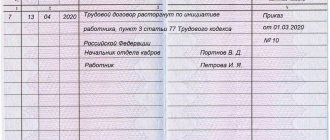Appealing dismissal in court
Sometimes the most effective way to appeal your dismissal is to file a claim in court and defend your rights in court. But you need to prepare for the process, write the statement of claim correctly, submit a set of documents and not miss the deadline for filing the claim.
Expert opinion
Kuzmin Vasily Stanislavovich
Lawyer with 6 years of experience. Specialization: criminal law. More than 3 years of experience in developing legal documentation.
The claim is drawn up taking into account procedural rules, that is, it is necessary to take into account the norms prescribed in Art. 130 – 131 Code of Civil Procedure of the Russian Federation. The following documents must be attached to the statement of claim:
- a copy of the claim for the defendant, that is, for the employer;
- documents confirming the plaintiff’s employment with this employer. All papers that are in one way or another related to the plaintiff’s employment must be issued by the defendant within three days after the plaintiff writes a written statement;
- receipt of payment of the duty. Without this document, the claim will not be accepted for consideration.
The plaintiff has the right to demand from the court a decision to reinstate him at work, as well as payment of wages for forced absence and compensation for damage caused by illegal dismissal. The calculation of the amount of damage is made by the plaintiff independently.
The amount of unpaid wages must be confirmed by relevant certificates from the accounting department. They are issued upon dismissal, and the employer has no right to refuse to issue them to his employee.
The case will be considered on its merits if the following conditions are met:
- all documents are ready;
- the claim is drawn up correctly;
- the duty has been paid in full;
- all documents were submitted on time.
Rules for filing a claim
If the employment contract is illegally terminated, the employee can challenge the dismissal order in court. The appeal period is one month. If the employee missed this deadline for a good reason, the court may extend it.
To appeal against illegal dismissal, you must draw up a statement of claim, indicating the following information:
- the name of the judicial authority to which the application will be sent;
- plaintiff's details;
- basic information about the organization where the dismissed employee worked;
- a detailed statement of the essence of the dispute;
- description of the main complaints against management;
- requirements;
- list of attached documents.
A copy of the statement of claim is sent to the employer. The plaintiff's demands may be very different. He may request a correction in the work record, reinstatement, payment of stipulated compensation, payment for forced absence and compensation for moral damage.
If the dismissed person wants the employer to compensate for moral damage, he must indicate the amount of payment in the application . But then you need to provide facts and documents in court that will confirm that the damage was actually caused.
In addition to the statement of claim, other documents are needed:
- employment history;
- employment contract or claim against the organization;
- a copy of the order on admission and dismissal from work;
- certificate of average salary.
Depending on the situation, the court may require additional documents from the plaintiff.
If the person being dismissed before the trial wrote a complaint to the manager or to the trade union, then he can attach a copy of this statement. The employee can request all necessary documentation from the organization from which he was fired. The boss is obliged to provide it within three days after submitting a written application. If management refuses to satisfy the employee’s request, the court requests the documents.
Typically, a claim is considered within 30 days, but the judge may extend this period indefinitely. If the court rules in favor of the employee, then all legal costs are paid by the employer. An employee has the right to demand that his superiors pay him compensation for forced absence.
Through the court, an employee can also challenge dismissal under the article, but only if he did not write a statement of his own free will. In this situation, it will be quite difficult to prove the illegality of actions on the part of the manager.
Legal and illegal grounds for dismissal
Most often, the reason for dismissal is a conflict with the employer. But it is problematic to dismiss a good employee under the article.
Therefore, management begins to put pressure on him so that the employee quits “of his own free will .” Feeling this pressure, the employee resists. As a rule, in the end the management gets what it wants.
But if an employee knows for sure that he was fired illegally, he has the right to defend his rights in available ways.
- With staff reduction.
- In case of liquidation, bankruptcy or termination of business.
- In case of non-compliance with qualifications.
- When there is a change in management or chief accountant.
- In case of violation of duties by an employee.
- When committing an immoral act.
- When providing false documents during recruitment.
- In case of gross violation of duties (one-time).
This is important to know: The deadline for appealing a decision in a simplified manner under the Arbitration Procedure Code of the Russian Federation
Thus, dismissal is illegal in the following cases:
- The procedure for terminating the concluded agreement was violated.
- The employer did not pay the employee all the money due.
- The dismissal was made for a minor violation of discipline.
- The employee was fired while on vacation or sick leave.
- The employer forced the employee to submit an application “of his own free will.”
- The dismissal occurred due to staff reduction or liquidation of the company, but without properly notifying the employees (an employee who had a preferential right to remain at work was fired).
- The dismissed employee is the parent of a child under 14 years of age.
- There were other grounds that contradicted the law.
Reduction
Downsizing is not easy. With the appropriate decision of management, it is necessary to draw up a lot of paperwork. A special commission is also created that carefully studies the candidates. For this purpose, the following factors are taken into account:
- Experience with a specific employer.
- Degree of qualification.
- The presence or absence of benefits issued to individual employees. After the study, the team is notified about upcoming events. This must be done no later than two months before the start of dismissal. The employee is given severance pay equal to 2 salaries.
Dismissal at your own request and by agreement of the parties
When voluntary dismissal is contested, employees most often indicate that their superiors forced them to write a statement. In practice, this can only be proven if there are witnesses. But former colleagues are usually in no hurry to become witnesses. Therefore, it is best not to sign the corresponding application initially. Otherwise, it will be almost impossible to prove the pressure.
The same applies to dismissal by agreement of the parties. An exception is made only for pregnant employees if they can prove that they did not know about their pregnancy when signing the application.
Consequences of failure to timely apply to a judicial authority
What is noteworthy is that the court cannot refuse to accept the claim and documents even if the period for appeal has expired, and the essence of the application is:
appealing the decision of the CCC;
challenging the actions of an employer that violates the rights of an employee;
compensation for property damage caused to the enterprise;
recognition of an unlawful reason for refusing to employ an applicant;
discrimination of employee rights and interests;
unjustified dismissal with subsequent reinstatement with recovery of amounts for forced absence.
Proceedings on the above-mentioned applications occur only if none of the parties to the conflict declares that the deadline for appeal has expired. But still, one should not hope that the employer will ignore the fact that the limitation period has expired if the citizen went to court two months after dismissal with a demand to recover compensation payments and reinstatement.
If one of the participants files a motion to miss the deadline, the second will have to provide the court with documentary evidence of the existence of valid circumstances for non-compliance with the procedural order. It is possible to make a corresponding statement both orally and in writing. Further development of the case depends on whether the court accepts the received grounds as sufficient.
Dismissal for failure to perform duties
In this case, the employer will have to prove the legality of the reprimand and dismissal. Often, a job description specifies a duty in a generalized form, but the manager fires you for specific actions. In court, it may be found that nothing was actually violated, since the instructions did not contain clear instructions and prohibitions.
In addition, employers do not always request explanations from employees, and also violate the established deadline for waiting for explanations, which is 2 days. This may be a reason to cancel the dismissal and reinstatement.
What is a statute of limitations?
From the point of view of civil law, this term defines a certain period during which it is possible to file a claim in court to protect and restore violated rights. In paragraph 1 of Art. 196 of the Civil Code of the Russian Federation, the general limitation period is 3 years from the moment of actual detection of a violation of a citizen’s rights.
Meanwhile, in the Labor Code of the Russian Federation there is no concept of a “limitation period”, but there is a “term for filing a lawsuit”. Both concepts have the same essence, but when it comes to labor relations, it is more correct to talk about the time limit for going to court to resolve an individual labor dispute.
Methods of appeal
An appeal can be made in the following ways:
- By contacting your superiors, referring to the relevant provisions of labor legislation. In it, ask for clarification of the reason why the employment relationship is terminated. It also happens that senior management is not aware of the ups and downs taking place between employees. This happens especially often in large organizations in which many powers are exercised by deputies.
- Filing a complaint to a trade union if the employee is a member.
- By filing a complaint with the labor inspectorate indicating the circumstances of the termination of legal relations, as well as the provisions of the law violated by management and with a request to conduct an inspection of the company’s activities. If violations are detected, the inspectorate applies to the court in order to reinstate the applicant at work with payment of compensation for forced absences.
- Along with the appeal to the labor inspectorate, you can also write a statement to the prosecutor's office.
- In the event of a clear violation, it is possible to file a claim directly with a judicial authority.
How to restore the expired period
If there was a delay in contacting the authorized structures for labor disputes, the plaintiff can take advantage of the option of restoring the statute of limitations - for this you will need to send a corresponding petition indicating a valid reason. The list of permissible grounds has not been approved by law, so the court independently determines whether impeding circumstances can be used as sufficient to restore the expired period. At the same time, there is a specific definition of reasons of this kind, which is reflected in paragraph 5 of the Resolution of the Plenum of the Armed Forces of the Russian Federation No. 2 of 2004. There are also a number of examples:
This is important to know: The period of incapacity for work on sick leave: how long does it last and for what is the minimum period of sick leave?
serious illness or hospitalization - as evidence you will need to present a sick leave certificate or an extract from a medical institution;
being on a business trip - you will need a travel document or other documents confirming the plaintiff’s stay in another city for work;
caring for a seriously ill relative.
An individual approach allows for greater fairness, but the degree of correctness of the decision largely depends on the competence of the judge.
If the court decides to restore
The procedure for reinstatement at work is regulated by Chapter 60 of the Labor Code of the Russian Federation. The execution of the relevant court decision must be carried out immediately. This process is accompanied by the following points:
- By issuing a writ of execution, which the manager is obliged to execute within 1 working day.
- Reinstatement, which is carried out even if another employee is hired to replace the dismissed employee.
- Cancellation of the dismissal order.
- Notifying the employee of the start date of work.
- By making corrections to the work book.
- Returning the employee to the same position and with the same working conditions.
- By crossing out the dismissal on the employee’s personal card.
- Changing the working time sheet.
Procedure for reinstatement at work
If the court or the State Labor Inspectorate found that the dismissal was carried out illegally, then the employee must be reinstated in his previous place.
The restoration procedure is regulated by Chapter 60 of the Labor Code of the Russian Federation. To do this, the employer must cancel the dismissal order on the basis of a new order. It is drawn up in any form and given to the employee for review against signature. After this, the employee is notified in writing when he can start work and is asked to provide a work book.
The employee is required to be reinstated in his previous position, even if this position has already been taken by a new employee. A new entry is made in the work book, and the previous notice of dismissal is declared invalid.
In the employee’s personal card, the notice of dismissal is crossed out. If he was reinstated to work by decision of the labor inspectorate or court, then a note about this is made in an additional column and the main details (date and number) are entered. After this, the employee is required to count all days of forced absence and pay compensation.
If the employer committed gross violations in the process of terminating the employment contract, then it will not be difficult for the employee to prove that he is right. And in order not to waste time and achieve justice, you should contact the labor inspectorate and the court at the same time.
What kind of dismissal of an employee is considered illegal?
Expert opinion
Kuzmin Vasily Stanislavovich
Lawyer with 6 years of experience. Specialization: criminal law. More than 3 years of experience in developing legal documentation.
First of all, it is worth noting that dismissal will be legal only if it meets the grounds (one of) provided for by the Law (Articles 77-84 of the Labor Code). In other cases it will be illegal.
For example, at.
- Complete absence of grounds for dismissal.
- Violation of the dismissal procedure.
- Inconsistency of the circumstances that took place with the chosen basis (wording).
- Violation of guarantees/rights of certain categories of employees.
- Inconsistency with the position held based on the results of the probationary period (the employer will have to prove this to the court).
- The discrepancy between the punishment (note: dismissal) and the severity of the disciplinary act itself.
- Dismissal of a trade union member without taking into account the latter's opinion.
- Dismissal of mothers or single fathers, expectant mothers (note: exception - liquidation of the company).
- Dismissal of an employee who at that time is on leave (approx. - ordinary, maternity leave), on sick leave.
- For violation of the dress code or failure to comply with corporate ethics.
- For several reasons at the same time.
- Forcing you to write a statement on your own initiative.
- With the wording “staff reduction” in the absence of this procedure in reality.
- And etc.
When to appeal dismissal due to redundancy
The reduction should be challenged if it is illegal. Violations are as follows:
- reduction of persons with immunity (pregnant women, etc.);
- failure to comply with pre-emptive rights;
- overdue notice of layoff (it must be provided no later than 2 months in advance);
- failure to notify the union 2 or 3 months in advance;
- refusal of management to provide new positions;
- lack of a new schedule with an updated list of jobs.
Where to go in case of illegal dismissal of an employee?
To begin with, it is worth making an attempt to resolve disagreements before filing a lawsuit. In a written complaint to management, you should set out your requirements correctly and in detail, referring to the law.
This claim is drawn up in 2 copies, one of which is sent to the manager, and the second (with the employer’s mark) will be attached to the statement of claim.
As for conciliation commissions, despite the fact that the possibility of their creation is provided for in Chapter 15 of the Labor Code, in practice they are not created anywhere.
So where to complain?
- To the trade union. According to the law, it is impossible to dismiss a trade union member solely at the request of management and without the consent of the trade union body (Article 374 of the Labor Code). The complaint (claim) can be sent to the trade union body, which has the right to appeal the manager’s actions to the state labor inspectorate, which will oblige the employer to reinstate the employee and pay him compensation.
- State/labor inspectorate. After a complaint to this authority (note - you should write a statement), a legal inspector will conduct an inspection on the issue of violation of labor legislation and, based on its results, will take appropriate measures (Article 357 of the Labor Code): he will oblige the employee to be reinstated and compensate him for damages (Article 357 of the Labor Code). 234 of the Labor Code), and will also hold the manager accountable. Note: experts recommend not delaying the application to the court and submitting it simultaneously with the complaint to the State Tax Inspectorate. Why? Because the inspection by the GIT inspector is conditional and does not involve clarifying details, interviewing witnesses, checking the reality of the fact of reduction, etc. You can challenge the decision of the GIT, if it is not in favor of the illegally dismissed employee, within 3 months after it was made .
- To the prosecutor's office. Its powers are similar to those of the State Tax Inspectorate - inspection, prosecution, sending a protest to the employer regarding the dismissal order. Is it worth filing a complaint? Definitely worth it. Perhaps you will be lucky, and the prosecutor, using Article 45 of the Code of Civil Procedure, will file an application with the court with a corresponding claim (for your reinstatement).
- To the district court (note - at the place of the employer). An option for those who prefer to decide their destiny on their own. All court decisions are binding, and the process is monitored by bailiffs.
It is important to know: In what cases is the limitation period interrupted and extended?
Appealing a dismissal order
There are different ways to challenge the termination of an employment contract, but the employee must do this within a month after dismissal.
First, you can write a complaint to your manager. In it, competently, referring to the laws, you should state your position and try to convince that the dismissal was carried out illegally. This request must be made in two copies. One document must be submitted through the secretary to the manager, in the other the secretary must put his signature, date and registration number.
If at work they do not want to accept the application, then it can be sent by registered mail with notification and a list of all enclosed documents. Then the employee will have documentary evidence that he really worked in this organization and tried to resolve the current situation in a peaceful way.
You can send a complaint to the trade union body, but only if the employee was a member of it. The chairman of the trade union organization will forward this application to the State Labor Inspectorate, and there they will check the correctness of the termination of the employment relationship.
An employee can independently write a complaint to the labor inspectorate. If the employee was indeed fired illegally, measures will be taken to reinstate him and reimburse all due compensation. The State Tax Inspectorate can also bring the boss to administrative responsibility.
To challenge the dismissal, the employee may appeal to the district court. This method is the most common and effective. To do this, the employee needs to write a statement of claim and attach certified copies to it.
Preparing to go to court for illegal dismissal
Have you decided to go to court? In addition to optimism and a thirst for justice, you will need a certain package of documents , and a little preparation for the trial will not hurt.
- Your main document is your employment contract. And preferably, with the real size of your salary. If you don’t have one, ask your manager for a certificate of the average salary. This value will be needed in the process of reinstatement at work when calculating the recovery of the salary that you were not paid, and when calculating payment for forced absence. Otherwise, you will be charged the amount that the employer refers to. And it’s not a fact that it will reflect your real earnings.
- The manager is obliged to issue all documents and certificates to you upon your request within 5 days from the date of your application (Article 14, Labor Law). Doesn't it show? Violates deadlines? In the statement of claim (for the court), state your request to request these documents.
- Decide in advance - what exactly do you want from management? So that you are reinstated at work, entries are made in the work book, compensation for moral damages, repayment of arrears of wages or payment of funds due to you for the period of forced absence. The statement of claim must indicate all your claims and demands.
- Send a well-drafted complaint to management (before going to court and, preferably, drawn up with the help of a lawyer). Firstly, this will convince the employer of your desire to go to the end and, perhaps, solve the problem without litigation. Secondly, if there was no employment contract, then a correctly written claim will be one of the proofs that an employment relationship actually took place. You should keep the second copy of the document with a note from your manager about its receipt or with a postal receipt for sending it.
Documents - what will you need to file a lawsuit?
When going to court, prepare the following documents:
- Employment contract. Or, in its absence, a complaint to management (see above).
- Work book (of course, if available) with records of hiring/dismissal.
- A copy of the employment order.
- A copy of the order of dismissal from work.
- Certificate with information about the position held, specialty, and time of work.
- Certificate of average salary.
- Characteristics-recommendations with information about the employee’s attitude to the work performed and his qualifications.
- Acts on bringing to responsibility (if any) at the place of work.
- Evidence of the employer falsifying his arguments (if available).
- Other documents required by law.
- And, of course, the statement of claim itself.
What should be in the application?
First of all, your statement of claim must contain claims against management and a demand for your reinstatement at work. As for the time of forced absence, it is calculated from the day of dismissal until immediate reinstatement (that is, until the 1st working day). You can also demand that management compensate you for moral damages for wrongful dismissal. True, you will have to not only justify it, but also prove the fact of its application.
The procedure for appealing illegal dismissal - how does the trial work?
When considering any labor disputes in court, they are guided by the Civil Procedure Code (note: the civil procedural code), according to which a dismissed employee submits a statement of claim to the district court not at his own place, but at the location of the employer (exceptions - in Article 32, paragraph 8 of the Code of Civil Procedure)
- How is the trial going? The judge listens to both sides and other participants in the process, and
also analyzes all case materials. At the request of the dismissed employee, the judge may request additional documents, invite experts, or call witnesses. The participation of trade union representatives is also acceptable. - What is the plaintiff entitled to? During the proceedings, the plaintiff has the right to abandon his claim, change its basis, and change the amount of the claim. If the plaintiff wishes (requests), the court may decide to change the wording of the basis for the dismissal order (for example, to dismissal at his own request).
- Settlement agreement. Often this is where a legal labor dispute ends. But such a proposal should be treated with extreme caution. Particular attention is paid to the terms of the agreement that the employer offers you. Remember that once you enter into an agreement, you will lose the right to sue the claim again.
- Who is the defendant? Usually, in labor disputes, the defendant is not the immediate manager (director), but the organization itself (note - in the person of its representative). In some cases, these persons may coincide (individual entrepreneurs, for example).
- State duty - who pays? When resolving labor disputes, a dismissed employee is exempt from this type of payment (Article 501, paragraph 2 of the Tax Code).
- In what case will the plaintiff pay a fee? In the event that a claim is made (by the plaintiff) for compensation for moral damage caused. The amount of compensation is determined by the court.
- Moral damage. The amount of this compensation (if this fact is established by the court) will depend on the degree of guilt of the defendant, on the nature of the plaintiff’s suffering (note - moral/physical), evidence of this suffering and other circumstances.
This is important to know: Deadlines for appealing a Supreme Court decision
Execution of a court decision on illegal dismissal
If the court decides that the dismissal of the plaintiff was unlawful, the latter has the right to resume his work, and the unlawful dismissal is annulled.
- Compensation for funds lost as a result of forced absence. If the dismissal is declared illegal by the judge, then for the entire period of “absenteeism” the dismissed employee must receive an amount equal to the average salary for the entire period of absenteeism (approx. - no more than 3 months).
- Satisfaction of the claim. With such a court decision, all court costs, including fees, fall on the shoulders of the defendant.
- The claim was denied. If the plaintiff disagrees with such a decision, he has the right to appeal, the period of which is 15 days.
- The organization has been liquidated and restoration is impossible. What's next? In this case, the court decides to recognize the plaintiff as dismissed under Article 26, paragraph 1 of the Labor Law, with the subsequent payment by the employer (liquidation commission, successor) to the plaintiff of wages for the period of “absenteeism”.
- During the recovery period, the employee must be paid a salary. If an employee is transferred to a position with a lower salary, they are required to compensate the difference in income.
- Termination of a labor dispute. It is considered the moment of implementation of the judge’s orders in fact. That is, the labor dispute is over when the employee is reinstated and all due money is paid to him.
- The deadline for execution of a court decision is 15 days. If the employer is delayed in complying with court orders, the plaintiff is also paid compensation for all missed days.
Still have questions? Just call us:
What to do if you miss a deadline?
Absence without a valid reason will be a reason to refuse the claim. This is often how employers win dismissal cases.
However, there are a number of circumstances that are considered justifiable and justifiable for the delay in filing a claim. If the employee was on a business trip during this period, then it is necessary to provide supporting documents from the place of work: an appointment order, a financial calculation for the period of the business trip.
At the end of the trip, the employee must immediately submit documents to the court. A serious illness that has resulted in limited ability to work will also serve as a valid reason. To do this, you need to obtain an extract from the medical history or a copy of the medical commission’s protocol.
The illness of close relatives, which required care for them, must be documented not only from a medical institution. This will require consultation with a social worker and testimony. It is necessary to draw the court's attention to the fact that this particular person was directly involved in the care.
Expert opinion
Irina Vasilyeva
Civil law expert
There are a number of circumstances that are called “force majeure”. They can be interpreted by the court in different ways: divorce, death of a relative, difficult financial situation, and so on. They are determined by the judge as respectful during the trial itself in the courtroom.
Dear readers! To solve your problem right now, get a free consultation
— contact the duty lawyer in the online chat on the right or call: +7 Moscow and region.
+7 St. Petersburg and region. 8 Other regions of the Russian Federation You will not need to waste your time and nerves
- an experienced lawyer will take care of all your problems!
Illegal termination of an employment contract
Before dismissing an employee from an organization, the manager issues an order. The employee must read it and sign it. It is inappropriate to refuse to sign - in this case, an act is drawn up with the signatures of witnesses stating that the dismissed person was notified of the termination of the employment relationship with him.
If the employee believes that he was fired unlawfully, he should take a copy of this document. All the grounds on which an employee can be dismissed from an organization are spelled out in Articles 74−84 of the Labor Code of the Russian Federation.
In other cases, dismissal will be considered illegal. The most common situations in organizations are:
- the boss forced me to write a statement of my own free will;
- the manager violated the dismissal procedure;
- the employment relationship was severed with an employee who was on maternity leave, regular leave or sick leave;
- dismissal for misconduct with a minor disciplinary violation;
- refusal to pay due compensation;
- dismissal of a single mother who is raising a child under 14 years old;
- dismissal due to staff reduction without prior warning.
These are the most common cases, but they are not the only ones. Therefore, if an employee is sure that he was fired unlawfully, he can appeal such a decision.
Contacting the labor inspectorate
To appeal illegal dismissal to the labor inspectorate, you need to write a statement in any form. The document must indicate personal data, the name of the organization, list the main facts of violation of labor relations and put a date and signature.
All facts must be presented clearly, preferably with arguments and without exaggeration. If an employee does not know how to correctly file a complaint, inspection staff will help him do this. Typically, such an application is considered within a month, but in some cases the deadline can be extended by another 30 days.
But when contacting the State Tax Inspectorate, you should take into account that the decision they make is not always positive. Therefore, it is effective to file a complaint there when the employee has documents confirming obvious violations on the part of the employer.











